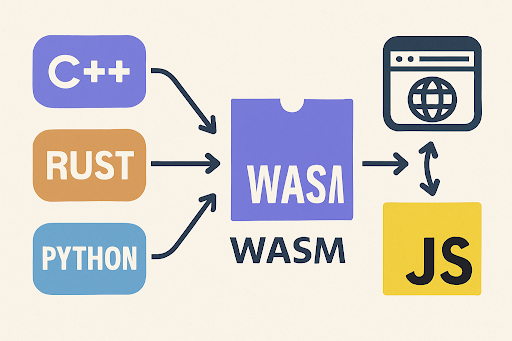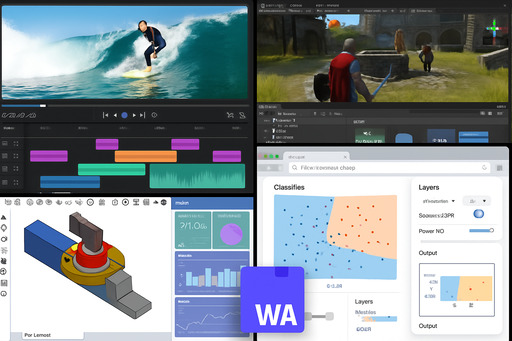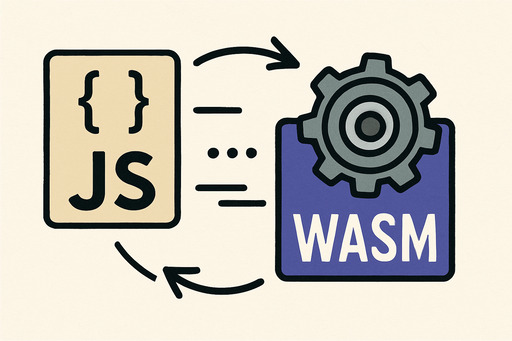
What is WASM and its use cases?
Web & App Development

The web, once a static collection of documents, has evolved into a dynamic and interactive platform. With this evolution comes an ever-increasing demand for performance, especially as web applications become more complex and feature-rich. From sophisticated in-browser games to powerful image and video editors, the boundaries of what's possible directly within a web browser are constantly being pushed. However, JavaScript, the traditional language of the web, while incredibly versatile, sometimes encounters limitations when dealing with computationally intensive tasks.
This is where WebAssembly (WASM) enters the scene. WASM is not a replacement for JavaScript, but rather a complementary technology designed to unlock new levels of performance and capabilities for web applications. It's a game-changer for developers looking to bring high-performance, desktop-grade experiences to the web. This blog post will delve into what WebAssembly is, how it works, its significant benefits, and explore its diverse use cases, with a particular focus on how it's transforming user interfaces.
What is WebAssembly (WASM)?

WebAssembly, often abbreviated as WASM, is a low-level binary instruction format for a stack-based virtual machine. In simpler terms, it\'s a type of code that modern web browsers can execute. Unlike JavaScript, which is a high-level, human-readable language, WASM is designed to be compact and efficient, running at near-native speeds. Think of it as a compilation target, meaning that code written in other programming languages like C, C++, Rust, or C# can be compiled into WASM and then run in a web browser.
The core idea behind WASM is to provide a portable, high-performance compilation target for web applications. When a developer writes code in a language like C++ and compiles it to WASM, the resulting `.wasm` file is a compact binary that can be downloaded by the browser. The browser then executes this WASM code within a secure, sandboxed environment. This execution happens alongside JavaScript, and the two can interact seamlessly, allowing developers to leverage the strengths of both technologies. For instance, JavaScript can handle DOM manipulation and high-level application logic, while WASM can be used for computationally intensive tasks like image processing or game physics.
Why WASM? The Benefits

The advent of WebAssembly brings a multitude of benefits that address many of the performance and development challenges faced by web applications today. These advantages make WASM a compelling technology for a wide range of use cases.
A. Performance: Near-Native Speed
One of the most significant advantages of WASM is its ability to execute code at near-native speeds. Because WASM is a low-level binary format, it can be parsed and executed much faster than JavaScript. This makes it ideal for computationally intensive tasks that traditionally struggled in the browser environment, such as complex calculations, real-time data processing, and high-fidelity graphics rendering. This performance boost can lead to a smoother, more responsive user experience, blurring the lines between web applications and native desktop applications.
B. Language Agnostic: Write in Your Preferred Language
Unlike JavaScript, which has historically been the sole language for client-side web development, WASM is language-agnostic. This means developers can write code in a variety of languages they are already familiar with, such as C, C++, Rust, Go, and even C#, and then compile it to WASM. This opens up the web to a vast ecosystem of existing libraries and tools, allowing developers to reuse their codebases and leverage the performance characteristics of these languages. This flexibility significantly reduces development time and effort, as teams don't need to rewrite entire applications in JavaScript.
C. Portability: Run Anywhere
WASM modules are designed to be highly portable. Once compiled, a WASM module can run not only in web browsers but also in other environments, such as Node.js, server-side runtimes, and even embedded devices. This 'write once, run anywhere' capability extends the reach of web technologies beyond the browser, enabling new possibilities for cross-platform development and universal application deployment. The WebAssembly System Interface (WASI) further enhances this portability by providing a standardized way for WASM modules to interact with the underlying operating system, similar to how Node.js allows JavaScript to access system resources.
D. Security: Sandboxed Environment
Security is paramount in web development, and WASM is built with security in mind. WASM modules run in a secure, sandboxed environment, isolated from the host system. This sandboxing prevents malicious code from accessing sensitive data or performing unauthorized operations. All interactions with the outside world, such as accessing the DOM or making network requests, must go through well-defined APIs, ensuring a controlled and secure execution environment. This inherent security model makes WASM a trustworthy technology for running untrusted code on the web.
WebAssembly\'s unique combination of performance, portability, and language agnosticism makes it an ideal candidate for a wide array of use cases, particularly in enhancing user interfaces and delivering rich, interactive web experiences.
WASM's Use Cases, Especially in User Interfaces

A. High-Performance Applications
One of the most immediate and impactful applications of WASM is in powering high-performance web applications that demand significant computational resources. This includes:
1. Image and Video Editing: Traditionally, complex image and video manipulation tasks were confined to desktop applications due to their heavy processing requirements. With WASM, developers can port existing C/C++ libraries for image and video processing directly to the browser, enabling real-time filters, effects, and editing capabilities that rival native applications. This allows users to perform sophisticated edits without needing to upload files to a server or download specialized software.
2. Games and Gaming Engines: WebAssembly is a game-changer for web-based gaming. It allows game developers to bring high-fidelity 2D and 3D games, originally written in languages like C++ or Rust, directly to the browser with near-native performance. This opens up possibilities for more immersive and graphically intensive web games, reducing load times and improving overall responsiveness. Popular game engines can also compile their output to WASM, further accelerating the development of web-native games.
3. CAD Applications and 3D Rendering: Computer-Aided Design (CAD) software and other applications requiring complex 3D rendering benefit immensely from WASM. By offloading the heavy computational work of rendering and model manipulation to WASM modules, web-based CAD tools can offer smooth, interactive experiences, allowing engineers and designers to work directly in their browsers without compromising on performance or visual quality.
B. Data-Intensive Applications
WASM's ability to handle large datasets and perform rapid computations makes it invaluable for data-intensive web applications:
1. Data Visualization: Interactive data visualizations often involve processing and rendering large volumes of data in real-time. WASM can significantly accelerate these processes, enabling smoother animations, faster data updates, and more complex visualizations directly within the browser. This allows users to explore and interact with large datasets without experiencing lag or performance bottlenecks.
2. Machine Learning in the Browser: Running machine learning models directly in the browser offers numerous advantages, including reduced latency, enhanced privacy (data doesn't leave the user's device), and offline capabilities. WASM makes this feasible by providing a high-performance runtime for machine learning inference. Developers can compile pre-trained models or even entire machine learning frameworks to WASM, allowing web applications to perform tasks like real-time object recognition, natural language processing, or facial detection directly on the client-side.
C. Leveraging Existing Codebases
One of the most practical benefits of WASM is its ability to facilitate the reuse of existing codebases, saving significant development time and resources:
1. Porting Desktop Applications to the Web: Many established desktop applications have extensive codebases written in languages like C++ or C#. WASM provides a pathway to bring these applications to the web without a complete rewrite. This allows companies to extend the reach of their software to a broader audience through web browsers, offering a consistent user experience across platforms.
2. Reusing Libraries Written in Other Languages: Developers can leverage a vast ecosystem of high-performance libraries and algorithms written in languages other than JavaScript. For example, a web application might need a highly optimized cryptography library written in C, or a complex physics engine developed in Rust. WASM enables the seamless integration of these pre-existing libraries into web projects, avoiding the need to reimplement them in JavaScript and ensuring optimal performance.
D. Edge Cases and Future Possibilities
WASM's versatility extends to emerging technologies and niche applications:
1. Augmented and Virtual Reality (AR/VR): AR/VR experiences demand extremely low latency and high frame rates to prevent motion sickness and provide a realistic feel. WASM's near-native performance is crucial for rendering complex 3D environments and processing sensor data in real-time for web-based AR/VR applications.
2. Blockchain and Cryptography: Applications involving blockchain technology or intensive cryptographic operations can benefit from WASM's performance and security. Performing cryptographic computations directly in the browser via WASM can enhance the speed and security of decentralized applications.
V. WASM and JavaScript: A Collaborative Future
It’s crucial to understand that WebAssembly is not intended to replace JavaScript. Instead, the two technologies are designed to be complementary, working together to create more powerful and efficient web applications. Think of them as partners, each excelling in different areas.
A. Not a Replacement for JavaScript
JavaScript remains the dominant language for web development, and for good reason. It's excellent for handling DOM manipulation, event handling, and general application logic. Many tasks in web development are best suited for JavaScript, and it continues to evolve with new features and performance improvements. WASM is not designed to take over these roles but rather to augment JavaScript's capabilities.
B. Complementary Roles: JavaScript for DOM Manipulation, WASM for Heavy Lifting
The ideal scenario for WASM and JavaScript is a collaborative one. JavaScript can continue to manage the user interface, handle user interactions, and orchestrate the overall application flow. When a computationally intensive task arises—such as decoding a video stream, running a complex simulation, or performing a large data transformation—JavaScript can offload this work to a WASM module. Once the WASM module completes its task, it can return the results to JavaScript for further processing or display.
C. Interoperability
The seamless interaction between JavaScript and WASM is a cornerstone of their collaborative future. The WebAssembly JavaScript API allows JavaScript code to load, compile, and execute WASM modules. It also provides mechanisms for passing data between JavaScript and WASM, and for WASM modules to call JavaScript functions and vice-versa. This interoperability ensures that developers can easily integrate WASM into their existing JavaScript projects, gradually introducing performance-critical components without a complete overhaul of their codebase.
Performance Benefits: The Numbers Don't Lie

Benchmark Comparisons
Operation | JavaScript | WebAssembly | Performance Gain |
|---|---|---|---|
| Mathematical computations | 1000ms | 50ms | 20x faster |
| Image processing | 2500ms | 180ms | 14x faster |
| Cryptographic operations | 800ms | 45ms | 18x faster |
| Data compression | 1200ms | 85ms | 14x faster |
Real-World Performance Stories
Figma: Migrated their rendering engine from JavaScript to WASM, achieving:
- 3x faster file loading
- 50% reduction in memory usage
Smoother real-time collaboration
Google Earth: Ported their native application to the web using WASM:
- Eliminated the need for browser plugins
- Maintained desktop-level performance
- Enabled access on any device with a modern browser
Getting Started: Your First WASM Application
Prerequisites
- Modern browser (Chrome 57+, Firefox 52+, Safari 11+)
- Development tools (Emscripten for C/C++, wasm-pack for Rust)
Simple Example - C++ Function in Browser
cpp
extern "C" {
int fibonacci(int n) {
if (n <= 1) return n;
return fibonacci(n-1) + fibonacci(n-2);
}
}
2. Compile to WASM
bash
emcc math.cpp -o math.js -s EXPORTED_FUNCTIONS="['_fibonacci']"
3. Use in JavaScript
javascript
Module.onRuntimeInitialized = () => {
const result = Module._fibonacci(40);
console.log(`Fibonacci(40) = ${result}`);
};
Current Limitations and Future Outlook
Present Challenges
- Debugging: Limited debugging tools compared to JavaScript
- Integration Complexity: Requires build tools and compilation steps
- File Size: Binary files can be larger than equivalent JavaScript
- DOM Access: Cannot directly manipulate DOM (must go through JavaScript)
Future Developments
- WASI (WebAssembly System Interface): Standardizing system-level APIs
- Garbage Collection: Native memory management improvements
- Threading: Multi-threading support for parallel processing
- Component Model: Better modularity and composition
Browser Support and Ecosystem
Current Support
- Chrome/Edge: Full support since 2017
- Firefox: Comprehensive implementation
- Safari: Complete WASM 1.0 support
- Mobile: Available on all modern mobile browsers
Development Tools
- Emscripten: C/C++ to WASM compiler
- wasm-pack: Rust to WASM toolchain
- AssemblyScript: TypeScript-like syntax for WASM
- WABT: WebAssembly Binary Toolkit for debugging
VI. Conclusion
WebAssembly (WASM) marks a transformative leap in web development, breaking the JavaScript monopoly and unlocking true high-performance computing within the browser. Far from replacing JavaScript, WASM complements it—allowing both technologies to excel where they perform best.
By enabling developers to compile code from languages like C, C++, and Rust, WebAssembly opens the door to reusing decades of mature codebases and bringing powerful native-like experiences to the web. This has made it possible to port complex desktop applications, enhance real-time image and video editing, power 3D gaming engines, and run machine learning models—all directly in the browser.
As WASM continues to mature and gain traction, the line between web and native applications grows increasingly thin. Developers are no longer limited by the performance constraints of traditional web technologies. Instead, they are empowered to create new categories of interactive, secure, and portable applications that redefine what’s possible online.
The future of the web is more performant, more interactive, and undeniably more binary—driven forward by the capabilities of WebAssembly.